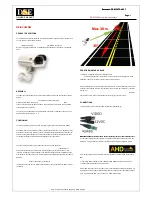
ed, you can believe the film-speed set
ting. Naturally, Minolta has a special top
cover w hich holds the film-speed dial in
position for tests and adjustments (ASA
100, 0 compensation). But, w itho u t the
special top cover, you'll have to make
sure the parts do n 't shift out of position.
Fig. 32 illustrates the operation of the
film-speed resistor. Setting the film speed
moves the film-speed brush along the
resistance band; changing the compensa
tion setting rotates the resistor ring. In
either case, you're changing the resis
tance between the blue wire and the gray
wire to program the operational amplifier
inside IC1.
If you measure the resistance between
the purple wire and the gray wire, Fig. 32,
you should read the value of the entire
resistance band — around 28K. Between
the blue wire and the gray wire, you
should see the resistance smoothly
decrease as you set slower film speeds;
the resistance should go from around 28K
to around 847 ohms. Here are the re
sistance values measured from a repre
sentative camera for different compensa
tion settings at A SA 100:
+ 1
5.84K
0
9.06K
-1
12.55K
CHECKING THE MODE SWITCH
Before replacing the speed knob, you
might take a look at the speed selector
and the mode switch at the wind-lever
end of the camera. Fig. 33. A t the " A ”
setting, the nut on the mode switch
comes against the mask lever. The nut
then pushes the mask lever in a clockwise
direction. In turn, the mask lever pulls the
mask over the w indow for the shutter-
speed indication. Remember, the shutter-
speed setting has no meaning in the " A "
mode.
The spring-loaded scale to the front of
the pentaprism provides the shutter-
speed indication. Fig. 34. A tungsten wire
couples the shutter-speed scale to the
speed selector. Turning the speed selec
tor in a counterclockwise direction draws
the tungsten wire from left to right in Fig.
34. The tungsten wire then pulls the
shutter-speed scale to the faster-speed
calibrations. Notice that you can rotate
the wire-hooking nut. Fig. 33, to precisely
align the shutter-speed calibrations
through the finder.
Certain malfunctions in the electronic
operation might lead you to suspect a
problem w ith the mode switch. For exam
ple, suppose that there's poor brush con
tact or dirty contact surfaces. Poor con
tact at the left-hand side of the brush.
Fig. 33, causes the overrange LED to re
main on. Also, the shutter delivers only its
mechanical speed. Poor contact at the
right-hand side causes the shutter to
hang open at all modes.
Later models of the camera have a sup
port arm above the mode switch; the sup
port arm maintains firm brush contact.
Figure 32
Figure 33
But, in earlier models, the mode switch
should be one of your first suspects. You
can pinpoint a problem to the mode
switch by using voltage tests. However,
you might first replace the speed knob
and the wind lever. You’ll then be able to
troubleshoot most of the electronics in
the camera — even though you can't as
yet reach all of the actual components.
Figure 34
PURPLE
FILM -SPE ED BRU SH
^ V W V W W V A
BLUE
G RAY















































